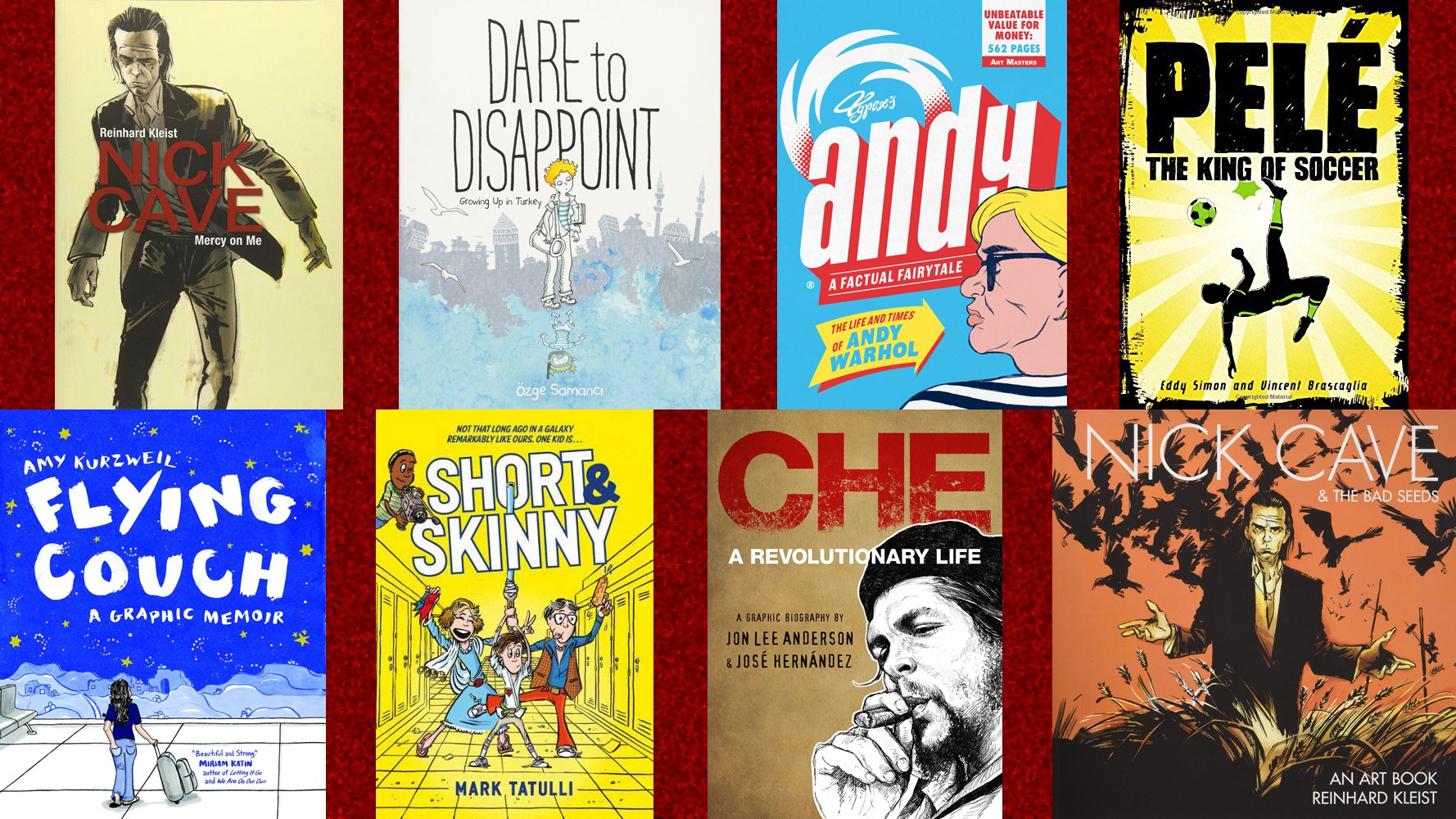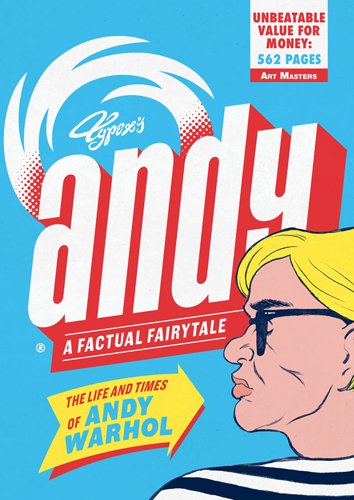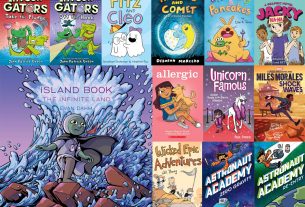This week’s Stack Overflow is about comic book biographies and memoirs, with a mix of old and new books. Many of these were written for adult audiences, so they do include sex, drugs, and rock ‘n’ roll, along with language and violence. Some are about well-known figures, and some are about people you may never have heard of. The one thing they have in common is that they use the comic book medium to portray the lives of their subjects.
Short & Skinny by Mark Tatulli
Short & Skinny is solidly a middle grade book—it’s Tatulli’s recollection of the summer of 1977, when he was in middle school. But because of the date—it’s the year Star Wars hit theaters—I’m guessing there are a lot of geeks from our generation who may connect with the story, too. Mark Tatulli is, as the title states, short and skinny. He gets picked on by the neighborhood bullies and is the shortest kid in his family (even though his sister is younger than him). But this summer, he has a plan: he’s saved up his money and spent it on all of those “get muscles in 30 days!” secrets that he spots in the ads in his comic books, hoping that one of them will work. (Spoiler alert: no.) But he also sees Star Wars, which inspires him to make his own parody film. And for once, he discovers that maybe being short and skinny doesn’t mean that he can’t do big things. It was a fun, quick read, and could be an encouraging tale to kids who, like Mark, aren’t the most popular, whether it’s because they’re small or have geeky interests.
Pelé: The King of Soccer by Eddy Simon and Vincent Brascaglia
How did Edson Arantes do Nascimento become Pelé: the king of soccer? This comic book biography tells his story, from kicking around a ball made of rags as a kid in São Paolo, to getting recruited to a professional team as a teen, to winning the World Cup for Brazil when he was only seventeen … and then beyond. Pelé was a big part of the reason soccer had a surge of popularity in the late 1970s in the United States—I remember his name from when I was a kid in the ’80s—but I didn’t know that that was actually the ending of his professional soccer career. He had actually retired already, but was convinced to come to the US to help give soccer a boost here.
The book shows how Pelé had natural talent, honed by years of practice, and the soccer matches are boiled down to the highlights. I enjoyed learning a bit more about the context of these soccer matches—Brazil’s unexpected loss to Uruguay in 1950, for instance, which was a huge sore point for the country. The book also gets into some of the politics of Brazil during Pelé’s career, including times when the team got caught up as pawns in political games. And despite his successes in sports, Pelé wasn’t perfect; we also read a little about his infidelities and times when he said some regrettable things.
It’s a fascinating story, aimed at middle grade readers, and I think will appeal especially to young soccer fans. I appreciated the inclusion of a lot of non-English words (along with footnoted translations), which remind the reader that most of the dialogue this story isn’t actually happening in English.
Dare to Disappoint: Growing Up in Turkey by Özge Samanci
Özge Samanci tells the story of her childhood and young adulthood in Turkey, from having a crush on her first teacher to the indoctrination that Turkish children had about their founding father Atatürk, to difficult decisions about what she would do with her life when she grew up. The book has snapshots of what it was like to be a kid in Turkey—some of it seems very familiar, like the interactions with her older sister or her struggles to find approval from her dad. But there are other parts that are distinctly different: life under authoritarian rule, broadcasts that are abruptly suspended any time a show became too contrary to the government, the paths required to get into a good secondary school and high school (instead of just college). There are also references to hyperinflation, the way that their money quickly lost its value, and the struggles of being from a more liberal family in a mostly conservative Muslim community.
Little Özge really wants to please her father, who puts practical considerations about her career future as the highest priority, but her grades aren’t as good as her sister’s, and she struggles to achieve academically. She also has dreams of doing other things—becoming a scuba diver or an actress, for instance. The book is about learning to fit all these pieces together, and which pieces she might have to leave out. I really enjoyed the snapshots of life in Turkey, and Samanci’s illustrations really help us see the world from her perspective. most of the book is drawn, but there are collage elements throughout as well that help the illustrations pop out. Dare to Disappoint is probably okay for middle grade readers, though there are a few references to dissidents being tortured or killed, and there is also a scene in which Samanci is assaulted, but manages to get away.
Flying Couch by Amy Kurzweil
This memoir depicts Amy Kurzweil as she wrestles with her identity. Her grandmother (“Bubbe”) survived the Holocaust by pretending to be a Polish Catholic orphan, and eventually made her way to the United States. Amy illustrates her grandmother’s stories, as well as her own explorations of what it was like growing up as a Jew in America: her experience is more secular, though she does take a Birthright trip to Israel as a young adult. The book also includes some scenes with Amy’s mother, Sonya, a therapist; the way she deals with young Amy’s hypochondria and inability to fall asleep was pretty amusing to me. (Incidentally, Amy’s father is Ray Kurzweil, but he’s barely mentioned in the book.)
The artwork has a sketchy look to it, not as polished as some of the other comics on this list, but it conveys the story well, and it feels personal and intimate. Bubbe’s stories are painful to read, and show a close-up look of what it was like to live through World War II as a Jew, and the contrast with Amy’s own life is striking. Overall, it’s an engaging story both about family and identity and the horrors of the war.
Che: A Revolutionary Life by Jon Lee Anderson & José Hernández
I’ll be honest: I didn’t know much about Che Guevara before reading this book, other than that he was a revolutionary of some sort and that his face adorned a lot of T-shirts and posters. This hefty graphic biography digs into the life of Ernesto Guevara, focusing primarily on his life after he graduated from the University of Buenos Aires and embarked on what became a lifelong quest. Anderson remarks in his introduction that Che is seen as a hero to some, and a sadistic murderer by others—and those extremely different viewpoints are what prompted him to learn more, eventually writing a biography, Che Guevara: A Revolutionary Life, upon which this adaptation is based.
Guevara is definitely a complicated figure, but he pursued his goals passionately and single-mindedly. Among them was defeating US imperialism, which he saw as a threat to all of South America. The book delves into his time with Fidel and Raul Castro, invading Cuba with a tiny group of men and overthrowing the government there. But that wasn’t enough—he travels to Tanzania, Bolivia, Argentina, always in support of rebellions. He also marries twice and leaves his wives and children behind, not sure if he’ll ever see them again.
Hernández’s illustrations are remarkable, with a photographic quality to them, and the book often incorporates materials like newspaper headlines, passports, and other documents. The book doesn’t shy away from some graphic depictions of violence and war, though it doesn’t dwell on them either. I did find some parts of it hard to follow, though, simply because of my own ignorance of the people and places—when the book jumps to a new place and shows some people having a conversation, I don’t always know who they are, or what the greater historical context. I imagine the prose biography probably includes a lot more of this background. There were also some places where the text (particularly reproduced newspaper headlines) wasn’t translated to English, but Google Translate helped me get at least a rough sense of what they said. I found myself both impressed by the sheer amount that Guevara was able to accomplish in his life, even if I didn’t agree with his methods or all of his ideology. Regardless of your opinion of Guevara, if you’d like a visually impressive way to learn more about the man behind that iconic portrait, this book provides a fascinating way to do it.
Nick Cave: Mercy on Me by Reinhard Kleist
I also knew pretty much nothing about Nick Cave, an Australian musician who started off playing punk (or post-punk?), before traveling around the world, playing in several different bands. Many of his songs are narrative, telling stories (usually tragic, it seems), and Reinhard Kleist uses them to create a biography that’s a blend of fact and fiction. He tells the story of Cave growing up and moving to London, and then Berlin, about his falling in love, writing a heroin-inspired novel… but he also casts Cave as characters in several of his songs: he’s the killer in “Where the Wild Roses Grow,” the executioner in “The Mercy Seat.” You get pieces of stories, and then the same scene repeated but from the perspective of one of the other people involved.
The result is an almost dreamlike story that weaves in and out of reality but works to paint a picture of Cave’s rise to stardom, with all the highs and lows of a rockstar life. I can’t say that it made a fan of me—I pulled up a few of the songs to listen to while reading those sections of the book, and it’s not really my style, beyond the fact that most of the songs seem to end in violent and disturbing deaths. But the book is visually impressive, and Kleist’s black-and-white illustrations are powerful and full of energy.
Nick Cave & the Bad Seeds: An Art Book by Reinhard Kleist
This companion to the graphic biography is a large coffee table book that features a lot of the artwork Kleist made while working on Mercy on Me. It includes some of the illustrations that eventually made it into the comic book, but also a lot of other drawings of Nick Cave and his band members, or Cave as various characters from his songs. Here, though, the large format of the book really lets you appreciate all the details of the illustrations, and many of them are in color. There are also comic book versions of three songs: “Deanna,” “The Good Son,” and “Stagger Lee.” This would make a great gift for fans of Nick Cave, and pairs nicely with the graphic biography.
Andy: A Factual Fairytale by Typex
This is a huge book about Andy Warhol, dense both in content and the physical material itself: it’s one of those books that you pick up and realize that it’s a lot heavier than you expected (and you didn’t expect it to be light, at well over 500 pages). The book itself is striking: shiny silver page edges, and a back cover that looks a bit like ads from the backs of old comic books. Inside, the book is divided into 10 “books,” each one kicked off with a page of “profile cards” that you could “cut out and keep,” introducing you to various characters that show up somewhere in the story. The story itself is primarily told in a strict 3×3 grid, with occasional splash pages, and the style shifts as you move through the book, from mostly black-and-white drawings to bright primary colors to muted full color, reflecting the different printing processes and styles of the time.
The narrative follows Andy Warhol from his early childhood all the way to his death, and it is an amazing, disturbing story, filled with outlandish characters and a bunch of celebrities and all sorts of artistic pursuits. I know some of Warhol’s work, of course, but there was still a lot of his work that I hadn’t heard of, and I also didn’t know much about his personal life. Just reading about it all was somewhat exhausting. Typex (the Dutch comics artist Raymond Koot) doesn’t shy away from showing all of Andy, warts and all. Despite his groundbreaking artwork and wild lifestyle, Warhol is often inarticulate and unsure of himself; he surrounds himself with an entourage, but doesn’t seem to have much loyalty to them, and in many cases abandons people when he tires of them.
There are so many famous faces that appear throughout the book: musicians like Bob Dylan and Mick Jagger, artists like Keith Haring and Jackson Pollock, even a young Donald J. Trump. Some just appear for a moment or two, a chance meeting, and others have close relationships with Warhol—or at least as close as Warhol ever seemed to let people get to him. Connecting to some of the other books in this list, we see Warhol’s assistant making prints of Che Guevara, and once he shows up in Pelé with Mick Jagger just for a frame or two. The sheer span of Warhol’s artistic career is impressive, and I found myself looking up a lot of things on Google to read a little more about them. If you want to know more about Andy Warhol, this is definitely a great place to start (if you’re an adult, that is—it’s decidedly not kid-friendly).
Disclosure: I received review copies of these books.












